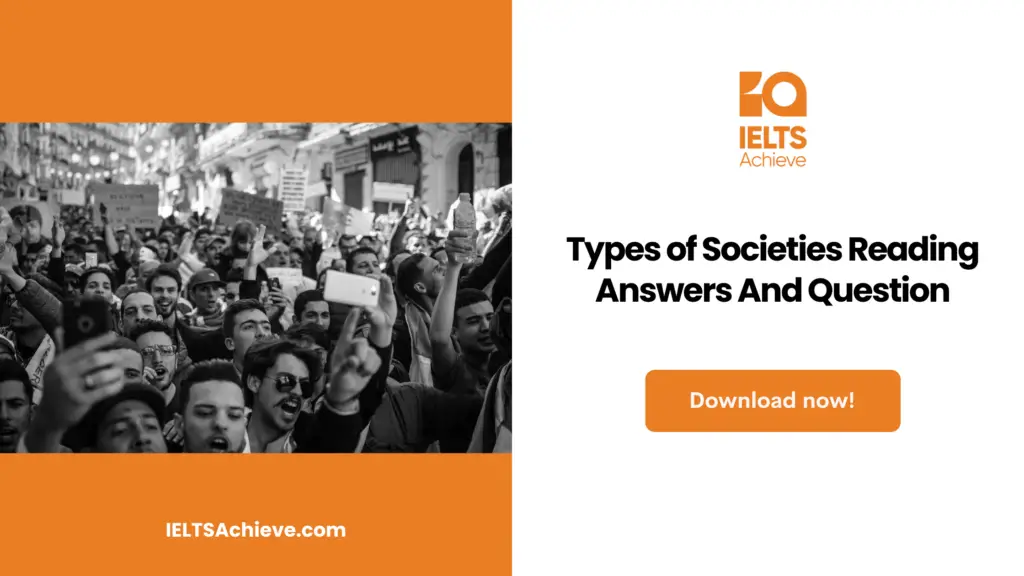The Blog post contains the following IELTS Reading Questions:
- IELTS Reading Summary completion
- IELTS Reading True/False/Not Given
- IELTS Reading Short Answer Question
Stay informed and prepared for success – Explore our comprehensive Reading Test Info page to get valuable insights, exam format details, and expert tips for mastering the IELTS Reading section.
IELTS Academic Reading Passage: Types of Societies

Types of Societies
Despite the fact that humans have created a wide variety of societies throughout history, sociologists and anthropologists typically distinguish between them based on how unequally access diverse communities within a society have to perks like resources, prestige, or power. They typically distinguish between four basic types of societies. Clans, tribes, chiefdoms, and states are ranked from least to most socially complex.
Clan
These are small-scale hunter-gatherer cultures that typically have less than 100 members and travel about seasonally to take advantage of wild (undomesticated) sources of food. This category includes the majority of still-existing hunter-gatherer societies, including the Hadza of Tanzania and the San of southern Africa. Members of a clan are typically kinsmen who are related by marriage or descent. Clans don’t have official leaders, thus there aren’t any obvious social or economic divisions among their members. Due to the fact that clans are made up of dispersed bands of hunters and gatherers, the majority of their locations are seasonal camps as well as other, more specialised and smaller sites. They include work sites, where tools are created, kill or butchery sites, where large mammals are slaughtered and occasionally butchered, and other such areas. Such a group’s base camp may show signs of very poorly constructed homes or temporary shelters, alongside the remains of residential occupation.
Tribe
They usually number and over a few thousand people, are typically larger than nomadic hunter-gatherer communities, and rely heavily on domesticated animals and cultivated vegetables for their diet and livelihood. Although they tend to be nomadic farmers with a completely diverse, mobile economy based on the intensive exploitation of animals, they are typically established farmers. These civilizations typically consist of several different groups that are connected to one another by familial relationships. Despite the fact that some tribes have representatives and even a “capital” or seat of government, these representatives lack the economic foundation required for the efficient utilisation of Tribal communities typically consisting of villages or settled agricultural homesteads. It is typical of the area that no one settlement predominates over the others. Instead, the archaeologist discovers proof of solitary, continuously inhabited homes or continuously inhabited settlements. The original farms in the Danube valley in Europe were made up of a group of free-standing homes, much like these settlements. Or they could be grouped together with clusters of buildings, such as the pueblos in the American Southwest and the historic farming community or small town of (catalhoyuk in contemporary Turkey).
Chiefdom
They work on the ranking principle, or the idea that people have different social positions. A scale of prestige is used to rank the lineages, and the senior lineage—and thus the society in its entirety—is led by a chief. A lineage is a collection of people who claim similarity. There is no real class division; prestige and rank are decided by how strongly one is associated with the chief. The chief’s job is very important. Locals frequently specialise in handicrafts, and surpluses of both of these and foodstuffs are periodically paid as a courtesy to the chief. They are used by him to keep up his retainers, and he can also distribute them to his subjects. The chiefdom typically has a centre of power, which is frequently home to temples, the chief’s and his retainers’ dwellings, and craftsmen . The population of chiefdoms varies widely, although the average range is between 5000 and 20,000 people.
Early state
They maintain many of the characteristics of chiefdoms, but the ruler (who may be a king or occasionally a queen) has the express right to enact laws and to enforce them using a standing army. Society is now split into various groups and no longer solely rests on blood bonds. The lowest classes are made up of agricultural labourers and the impoverished urban residents, followed by craft specialists, clerics, and members of the ruler’s family. The duties of the ruler are frequently distinguished from those of the priest: palace and temple. The society is seen as a realm controlled by the royal family, inhabited by tenants, and subject to taxation. A bureaucratic administration of officials is located in the central capital, and one of its main responsibilities is to collect money (typically in the form of taxes and tolls) and give it to the government, army, and craft specialists. To support these fundamental services, many early nations created intricate redistribution schemes.
Elman Service’s and William Sanders’ and Joseph Marino’s relatively straightforward social typology is open to criticism, thus it shouldn’t be applied carelessly. But, using words and thus concepts is necessary if we are to discuss early cultures. The types of services offer a helpful framework for structuring our thoughts.
Unlock your full potential in the IELTS Reading section – Visit our IELTS Reading Practice Question Answer page now!
Recommended Questions:
Renewable Energy IELTS Reading Question with Answer
Questions
Questions 1-4
Are the following claims accurate with the passage’s information? on your answer sheet write in boxes 1-4:
TRUE if the statement agrees with the information
FALSE if the statement contradicts the information
NOT GIVEN if there is no information on this
1. The economic status of clan members is generally similar.
2. A tribe’s farmers cultivate a variety of plants.
3. In a tribe, a single settlement is more significant than all the others combined.
4. The amount of land a person possesses determines his rank inside the chiefdom.
Enhance your skills in identifying information as True, False, or Not Given. Click here to discover expert strategies and techniques for mastering this question type in the IELTS Reading section.
Questions 5-7
Complete the provided summary below. Select NO MORE THAN TWO WORDS OR/AND A NUMBER from the passage for every answer. Fill in your responses in boxes 5-7 on the answer sheet.
They still resemble chiefdoms in many ways, but the ruler has the explicit authority to create laws and to enforce them with a 5._____________ . The foundation has changed and is no longer just based on familial ties. The roles of the ruler and the priest are frequently separated in the contexts of the palace and the temple. The 6._____________is perceived as a kingdom ruled by the royal family, populated by tenants, and governed by taxes. The central capital is headquarters to a bureaucratic administration of officials, its main responsibility is to 7. ___________ as well as distribute it to the authority, military, and craftspeople. Several early societies developed complex infrastructure to supply these core services.
Boost your performance in Summary, Notes, Table, and Flowchart Completion tasks. Click here to explore our detailed guide and learn how to effectively complete summaries, notes, tables, and flowcharts in the IELTS Reading section.
Questions 8-13
Answer the following questions. Select NO MORE THAN TWO WORDS OR/AND A NUMBER from the passage for each answer. Fill in boxes 8-13 on your answer sheet with your responses.
8. What are the clan work sites producing?
9. What other activities do tribes engage in outside established farming?
10. How are the residences in Catalhoyuk set up?
11. In addition to handcrafted goods, what else does a leader treat his subjects with?
12. What is a chiefdom’s maximum allowable population?
13. Which social class is higher than farmers yet at the bottom of an early state?
Unlock your full potential in the IELTS Reading section – Visit our IELTS Reading Practice Question Answer page now!
Recommended Questions:
Renewable Energy IELTS Reading Question with Answer
Answers for Types of Societies
1. Answer: True
2. Answer: Not Given
3. Answer: False
4. Answer: False
5. Answer: Standing army
6. Answer: Society
7. Answer: Collect money
8. Answer: Tools
9. Answer: Nomadic
10. Grouped together
11. Answer: Foodstuffs
12. Answer: 20,000
13. Answer: Craft specialists

We hope you found this post useful in helping you to study for the IELTS Test. If you have any questions please let us know in the comments below or on the Facebook page.
The best way to keep up to date with posts like this is to like us on Facebook, then follow us on Instagram and Pinterest. If you need help preparing for the IELTS Test, join the IELTS Achieve Academy and see how we can assist you to achieve your desired band score. We offer an essay correction service, mock exams and online courses.

